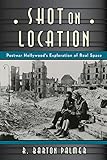Shot on Location : Postwar American Cinema and the Exploration of Real Place / R. Barton Palmer.
Material type: TextSeries: Techniques of the Moving ImagePublisher: New Brunswick, NJ : Rutgers University Press, [2016]Copyright date: ©2016Description: 1 online resource (270 p.) : 31 photographsContent type:
TextSeries: Techniques of the Moving ImagePublisher: New Brunswick, NJ : Rutgers University Press, [2016]Copyright date: ©2016Description: 1 online resource (270 p.) : 31 photographsContent type: - 9780813564081
- 9780813564104
- 791.430973 23
- PN1993.5.U6 P28 2016
- PN1993.5.U6 P28 2016eb
- online - DeGruyter
- Issued also in print.
| Item type | Current library | Call number | URL | Status | Notes | Barcode | |
|---|---|---|---|---|---|---|---|
 eBook
eBook
|
Biblioteca "Angelicum" Pont. Univ. S.Tommaso d'Aquino Nuvola online | online - DeGruyter (Browse shelf(Opens below)) | Online access | Not for loan (Accesso limitato) | Accesso per gli utenti autorizzati / Access for authorized users | (dgr)9780813564104 |
Frontmatter -- Contents -- Preface -- Acknowledgments -- Introduction: Real History, Real Cinema -- 1. Filming The Transitory World We Live In -- 2. The Postwar Turn Toward The Real -- 3. Of Backdrops And Place: The Searchers And Sunset Blvd -- 4. An American Neorealism? -- 5. Noir On Location -- 6. The Legacies Of The Ramparts We Watch -- Conclusion: Authentic Banality? -- Notes -- Index -- About The Author
restricted access online access with authorization star
http://purl.org/coar/access_right/c_16ec
In the early days of filmmaking, before many of Hollywood's elaborate sets and soundstages had been built, it was common for movies to be shot on location. Decades later, Hollywood filmmakers rediscovered the practice of using real locations and documentary footage in their narrative features. Why did this happen? What caused this sudden change? Renowned film scholar R. Barton Palmer answers this question in Shot on Location by exploring the historical, ideological, economic, and technological developments that led Hollywood to head back outside in order to capture footage of real places. His groundbreaking research reveals that wartime newsreels had a massive influence on postwar Hollywood film, although there are key distinctions to be made between these movies and their closest contemporaries, Italian neorealist films. Considering how these practices were used in everything from war movies like Twelve O'Clock High to westerns like The Searchers, Palmer explores how the blurring of the formal boundaries between cinematic journalism and fiction lent a "reality effect" to otherwise implausible stories. Shot on Location describes how the period's greatest directors, from Alfred Hitchcock to Billy Wilder, increasingly moved beyond the confines of the studio. At the same time, the book acknowledges the collaborative nature of moviemaking, identifying key roles that screenwriters, art designers, location scouts, and editors played in incorporating actual geographical locales and social milieus within a fictional framework. Palmer thus offers a fascinating behind-the-scenes look at how Hollywood transformed the way we view real spaces.
Issued also in print.
Mode of access: Internet via World Wide Web.
In English.
Description based on online resource; title from PDF title page (publisher's Web site, viewed 07. Jan 2021)


